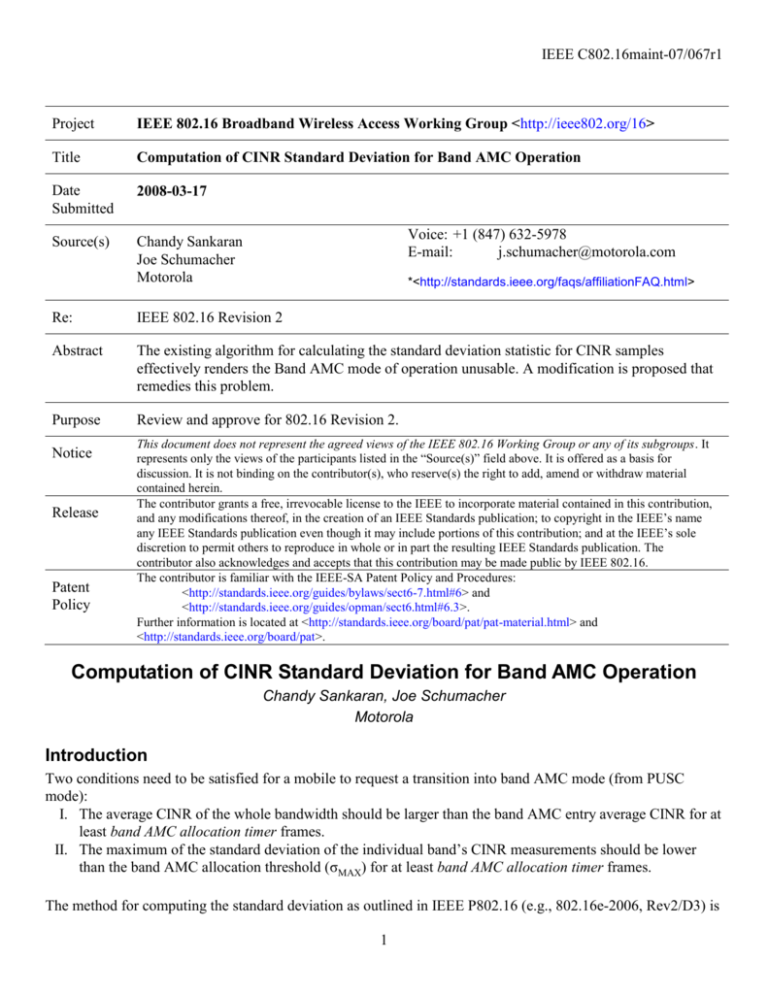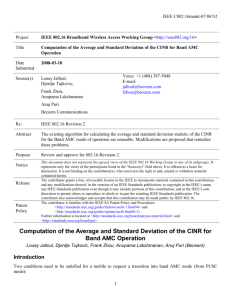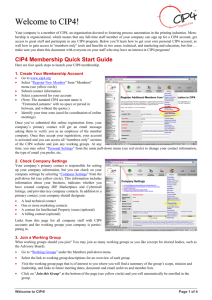Problem Definition
advertisement

IEEE C802.16maint-07/067r1 Project IEEE 802.16 Broadband Wireless Access Working Group <http://ieee802.org/16> Title Computation of CINR Standard Deviation for Band AMC Operation Date Submitted 2008-03-17 Source(s) Chandy Sankaran Joe Schumacher Motorola Voice: +1 (847) 632-5978 E-mail: j.schumacher@motorola.com *<http://standards.ieee.org/faqs/affiliationFAQ.html> Re: IEEE 802.16 Revision 2 Abstract The existing algorithm for calculating the standard deviation statistic for CINR samples effectively renders the Band AMC mode of operation unusable. A modification is proposed that remedies this problem. Purpose Review and approve for 802.16 Revision 2. Notice Release Patent Policy This document does not represent the agreed views of the IEEE 802.16 Working Group or any of its subgroups. It represents only the views of the participants listed in the “Source(s)” field above. It is offered as a basis for discussion. It is not binding on the contributor(s), who reserve(s) the right to add, amend or withdraw material contained herein. The contributor grants a free, irrevocable license to the IEEE to incorporate material contained in this contribution, and any modifications thereof, in the creation of an IEEE Standards publication; to copyright in the IEEE’s name any IEEE Standards publication even though it may include portions of this contribution; and at the IEEE’s sole discretion to permit others to reproduce in whole or in part the resulting IEEE Standards publication. The contributor also acknowledges and accepts that this contribution may be made public by IEEE 802.16. The contributor is familiar with the IEEE-SA Patent Policy and Procedures: <http://standards.ieee.org/guides/bylaws/sect6-7.html#6> and <http://standards.ieee.org/guides/opman/sect6.html#6.3>. Further information is located at <http://standards.ieee.org/board/pat/pat-material.html> and <http://standards.ieee.org/board/pat>. Computation of CINR Standard Deviation for Band AMC Operation Chandy Sankaran, Joe Schumacher Motorola Introduction Two conditions need to be satisfied for a mobile to request a transition into band AMC mode (from PUSC mode): I. The average CINR of the whole bandwidth should be larger than the band AMC entry average CINR for at least band AMC allocation timer frames. II. The maximum of the standard deviation of the individual band’s CINR measurements should be lower than the band AMC allocation threshold (σMAX) for at least band AMC allocation timer frames. The method for computing the standard deviation as outlined in IEEE P802.16 (e.g., 802.16e-2006, Rev2/D3) is 1 IEEE C802.16maint-07/067r1 performed using linear values of CINR moments and not decibel values of the CINR moments. This causes a problem when checking for condition (II) above. Problem Definition In the current version of the standard, the standard deviation is to be computed in the following manner: i. Compute the 1st moment of CINR as: ii. Compute the 2nd moment of CINR and the standard deviation as: 2 The problem with the above method is that ˆCINR [k ] and ˆ CINR [k ] are not computed as decibel values. This makes it difficult to use a single value of σMAX for a range of CINR values as shown below: Let xn, k = (ˆ [n 1, k ] + ε) be the mean CINR for frame n in band k. Assume xˆ 2 [n 1, k ] 2 [n 1, k ] . Then: ˆ [ n, k ] = (α. xn, k + (1-α). ˆ [ n 1, k ]) ˆ [ n, k ] = (1 ) = 0.43ε (assume α = 0.75) Let σMAX = 6 dB. Then allowed pairs of ˆ [ n 1, k ] and xn, k are: ˆ [ n 1, k ] = 0dB xn, k < 10dB ˆ [ n 1, k ] = 10dB xn, k < 12.8dB ˆ [ n 1, k ] = 15dB xn, k < 15.5dB ˆ [ n 1, k ] = 20dB xn, k < 20.4dB ˆ [ n 1, k ] = 30dB xn, k < 30.04dB Thus in the current standard, σMAX needs to be high before an MS with high CINR will request AMC: High σMAX low CINR users that cannot effectively use AMC are more likely to request AMC (AMC helps deserving low CINR users) 2 IEEE C802.16maint-07/067r1 Given a mix of users with different speeds, it becomes difficult to identify users that can effectively use AMC and users that cannot effectively use AMC. 35 mean CINR Boundary of allowed CINR variation 30 mean CINR boundary of allowed CINR variation 35 30 25 CINR (dB) CINR (dB) 25 20 PUSC PUSC 20 15 15 10 PUSC PUSC AMC eligible 10 AMC eligible 5 5 0 0 0 0 5 5 10 10 15 CINR (dB) 15 CINR (dB) 20 20 25 30 25 30 Figure 1: Allowed CINR variation for band AMC operation To illustrate this behavior, Figure 1 shows the allowed CINR variation for an MS to be able to request band AMC transition. The red line is the CINR value and the bounding blue lines are the allowed CINR variation. The blue line is 3σMAX, linear of the red line. Assuming a Gaussian CINR distribution, this should capture more than 99.9% of the expected distribution of the CINR. It is clear from this figure that low CINR users have a larger allowed variation as compared to high CINR users. Figure 2 illustrates how the proposed solution fixes the problem described earlier. 3 IEEE C802.16maint-07/067r1 Figure 2. Illustration of proposed solution Proposed Resolution 2 The proposed solution is to compute ˆCINR [k ] and ˆ CINR [k ] as decibel values: i. Compute the 1st moment of CINR as: ˆCINR,dB [k ] CINRdB[0] (1-avg ) ˆCINR,dB[k -1] avg CINRdB[k ] k 0 k 0 where: CINRdB[k ] 10log(CINRlinear[k ]) ii. Compute the 2nd moment of CINR and the standard deviation as: ˆ CINR,dB [k ] 2 (CINRdB [0])2 2 2 (1-avg ) ˆ CINR ,dB [ k 1] avg (CINRdB [ k ]) k 0 k 0 and standard deviation as: 2 ˆCINR,dB ˆ CINR [k ] (ˆCINR,dB[k ])2 ,dB Text Changes In equations 160 and 161, indicate that the computations are performed using decibel values for the mean and standard deviation, i.e.,: [Change equation 160 on page 1003 as indicated:] CINRdB[0] k 0 (1 avg ) ˆ CINR , dB[k 1] avgCINRdB[k ] k 0 ˆCINR , dB[k ] where CINRlinear[k] is a linear measurement of CINR for the k-th measurement; and n is number of consecutive frames in which no measurement is made. In frames where no measurement is made, the MS shall report the latest averaged results., and CINRdB[k ] 10 log 10 (CINRlinear[k ]) . 4 IEEE C802.16maint-07/067r1 [Change equation 161 on page 1003 as indicated:] (CINRdB [0]) 2 2 2 (1 avg ) ˆ CINR , dB [k 1] avg (CINRdB [k ]) 2 ˆ CINR , dB [ k ] 5 k 0 k 0






